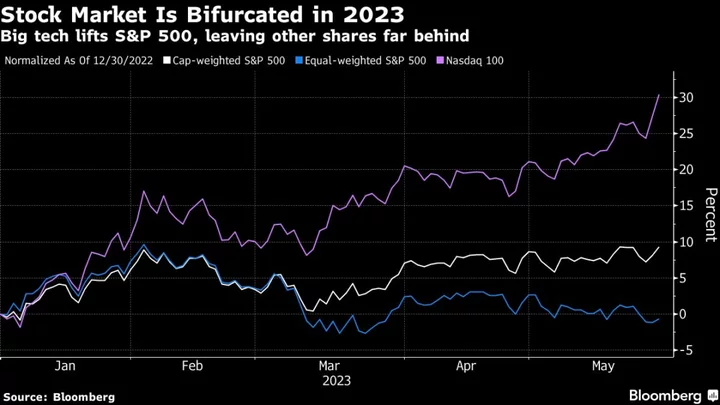Rarely does a tech-powered stock rally come along that isn’t pilloried for the fragility of its foundation. Now, with a snowballing craze for artificial intelligence pretty much propping up the market by itself, the haters are out in force.
Never has so much been owed to so few when it comes to the recent upward arc of indexes like the S&P 500 and Nasdaq 100, upon which trillions of passively invested dollars ride.
The top-heaviness of advance, on display all year, can be seen by comparing the Nasdaq 100 to a version of the same index that strips out its market-value biases. The equal-weighted one, which treats Apple Inc. the same as Dollar Tree Inc., has trailed the standard benchmark by 16 percentage points since January. In the S&P 500, the unweighted version is losing by the widest market since Bloomberg’s data began in 1990.
To much of the pundit class, the situation is replete with risk: what happens to the market when the hype-cycle around AI ends? Peter Tchir, head of macro strategy at Academy Securities, sees it differently. Piling into a few heavyweights is just investors “being rationally selective.”
“The relative performance of various sectors makes sense to me,” he said. “I’m eyeing the lack of breadth, but it’s not bothering me much at the moment.”
Supercharged by a $190 billion rally in Nvidia Corp., the Nasdaq 100 climbed for a fifth straight week with a 3.6% gain, trouncing other indexes amid smoldering concerns about rising interest rates and a recession.
Thanks to a blockbuster sales forecast from Nvidia., the seven largest tech stocks — also including Microsoft Corp, Alphabet Inc., Amazon.com Inc., Meta Platforms Inc. and Tesla Inc. — added a combined $454 billion in value over five days, pulling the S&P 500 to a second straight weekly gain.
Up a formidable 43% since January, the Big Seven’s median gain is almost five times the S&P 500. Valuations look stretched, with a price-earnings multiple of 35 that’s 80% above the market’s.
“These are good companies. They’re not going bankrupt. But people are starting to pay exorbitant prices for them. It feels frenzy-ish,” said Michael Mullaney, director of global research for Boston Partners. “If the leadership was all crappy companies like we saw in 2000, it would be game over very shortly.”
Warnings that this type of concentration will incinerate the wider stock market have been a recurring feature of commentary year after year. The latest came from Morgan Stanley’s top-ranked strategist Mike Wilson, who cited it as one reason that the equity advance is unsustainable.
But bailing out because of weak breadth has been the furthest thing from a sure-bet trading strategy, historically.
While tech’s extreme dominance in the late 1990s set the stage for the dot-com crash, there have been a total of 15 years over the past three decades when the equal-weighted S&P 500 trailed the cap-weighted version. Among them, only three gave way to losses 12 months later. In 1998, when the gap between the two widened to 16 percentage points, stocks kept rallying for another year.
In other words, there’s no obvious reason to expect a lopsided market to spell imminent doom. Instead, it’s usually a worsening fundamental backdrop that turns the tide, and when that happens, even the sturdiest companies can’t hold up.
Buttressing big tech’s superior performance now is a gale of tailwinds ranging from AI optimism to better-than-expected earnings and a flight to safety assets. Optimism that a debt accord would be reached also bolstered sentiment Friday.
Bill Harnisch, chief investment officer at Peconic Partners, whose fund is up 19% this year through Thursday, covered short positions in Microsoft earlier this year while adding to long holdings in Amazon and Alphabet. While sticky inflation and continued restrictive monetary policy suggest the market is likely to retreat from recent highs in coming months, he expects these tech giants to remain as safe havens for troubled investors.
“People gravitated for the seven names because we call them assured growth,” Harnisch said. “I don’t feel we’re missing anything with the market. It’s just amazing what’s going on underneath the surface. And if this AI thing is what we all think it will be, there’ll be a lot of opportunities beyond Nvidia.”
One constituency the oligarchic rally is indisputably creating headaches for is stock pickers. Five months into the year, only 33% of large-cap mutual funds are beating their benchmarks, compared with a historic average of 38%, according to data compiled by Goldman Sachs Group Inc. strategists including Cormac Conners and David Kostin. They attribute the lackluster performance to a chronic aversion to tech megacaps, a posture partly due to a Securities and Exchange Commission rule limiting a fund’s ownership in a single stock to 5%.
For everyone else — from passive buy-and-holders to hedge funds, the Big Seven’s relentless gain is either a non-issue or a route to relative riches. Hedge funds have boosted their holdings to 16% of their overall single-stock net exposure, up from 9.7% at the start of the year, data compiled by Goldman’s prime brokerage show.
In some ways, the anxiety over tech’s ascent reflects prevailing pessimism among investors who keep looking for things to distrust the equity rally. Yet despite all the traps lain in front of the market — recession, falling profits, an aggressive Federal Reserve — stocks have refused to budge. That’s in part because the very bearish stance leaves the market prone to more upside.
“We point to the lack of breadth in the market and the risks around crowdedness and concentration,” Bobby Molavi, a managing director at Goldman, wrote in a note. “Then we realize that people are under positioning and willing the market lower, and that for now, as has been the case for much of 2023, the market will not give the fans what they want.”
--With assistance from Jessica Menton.
Author: Lu Wang, Carly Wanna and Ryan Vlastelica

